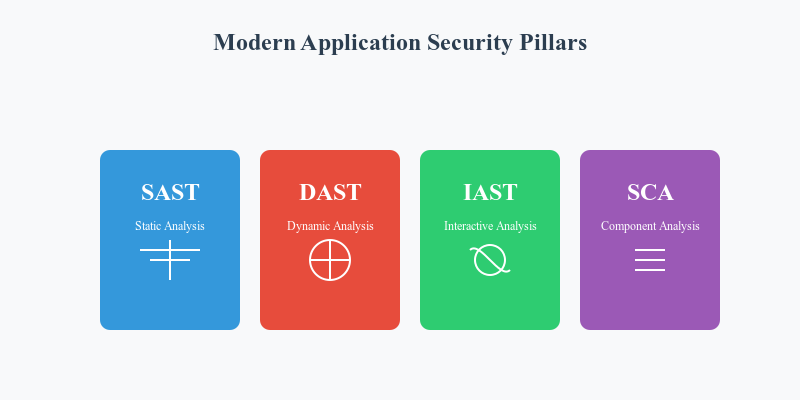La sécurité applicative est devenue un enjeu critique dans le paysage numérique actuel. Avec la montée des cyberattaques et la complexité des écosystèmes logiciels, les entreprises ont besoin d’approches avancées pour identifier et corriger les vulnérabilités. Parmi les méthodes les plus efficaces, quatre acronymes dominent : SAST, DAST, IAST et SCA. Cet article explore ces techniques, leurs différences, leurs avantages et comment les combiner pour une sécurité optimale.
1. Qu’est‑ce que le SAST (Static Application Security Testing) ?
Le SAST (Static Application Security Testing) consiste à analyser le code source, le bytecode ou les binaires sans exécuter l’application. Cette méthode est particulièrement efficace pour détecter des failles comme les injections SQL, les erreurs logiques ou les dépassements de tampon avant l’exécution du logiciel.
Atouts du SAST
-
Détection précoce : les problèmes sont identifiés pendant le développement, réduisant les coûts de remédiation.
-
Qualité de code améliorée : au‑delà de la sécurité, le SAST encourage des pratiques de code robustes.
Limites
-
Faux positifs : les outils SAST peuvent signaler des problèmes inexistants.
-
Pas d’analyse à l’exécution : les vulnérabilités exploitées en runtime ne peuvent être évaluées.
Outils populaires
-
SonarQube (with security plugins)
-
Checkmarx
-
Fortify Static Code Analyzer (Micro Focus)
-
Veracode (SAST module)
-
AppScan Source (IBM)
2. Qu’est‑ce que le DAST (Dynamic Application Security Testing) ?
Le DAST (Dynamic Application Security Testing) examine une application en cours d’exécution. Contrairement au SAST, cette approche simule des attaques réelles pour identifier des vulnérabilités exploitables, telles que les injections SQL, les failles XSS ou les erreurs de configuration.
Atouts du DAST
-
Perspective attaquant : les tests reproduisent des techniques utilisées par les attaquants.
-
Analyse en exécution : les vulnérabilités contextuelles sont évaluées selon le comportement de l’application.
Limites
-
Pas d’analyse au niveau du code : le DAST ne remonte pas jusqu’aux lignes de code.
-
Nécessite une application fonctionnelle : l’analyse n’est possible qu’une fois l’application déployée ou en test.
3. Qu’est‑ce que l’IAST (Interactive Application Security Testing) ?
L’IAST (Interactive Application Security Testing) combine les forces du SAST et du DAST. L’approche instrumente l’application pendant l’exécution afin d’analyser à la fois le code et son comportement en runtime.
Atouts de l’IAST
-
Précision accrue : moins de faux positifs grâce à l’analyse contextuelle.
-
Analyse continue : l’application est testée dynamiquement en fonctionnement.
Limites
-
Intégration complexe : l’instrumentation peut exiger une infrastructure avancée.
-
Impact sur les performances : peut ralentir l’exécution de l’application.
4. Qu’est‑ce que le SCA (Software Composition Analysis) ?
Le SCA (Software Composition Analysis) se concentre sur les bibliothèques open‑source et composants tiers utilisés par une application. L’objectif est d’identifier les vulnérabilités connues et de vérifier la conformité des licences.
Atouts du SCA
-
Gestion des dépendances : identifie rapidement les vulnérabilités des composants tiers.
-
Conformité légale : garantit le respect des licences open‑source.
Limites
-
Axé sur les composants tiers : ne couvre pas les problèmes propres au code propriétaire.
-
Maintenance continue : les bibliothèques doivent être mises à jour fréquemment.
5. Comment combiner ces approches pour une stratégie complète
Aucune méthode unique ne suffit à assurer une sécurité applicative complète. En combinant ces approches, vous pouvez bâtir une stratégie robuste et holistique :
-
Développement : utilisez le SAST pour analyser le code source tôt dans le processus.
-
Build : intégrez le SCA pour surveiller les bibliothèques et composants tiers.
-
Tests : adoptez DAST et IAST pour révéler les vulnérabilités exploitables et obtenir des insights en temps réel.
Dans un monde où les cyberattaques sont de plus en plus sophistiquées, l’usage combiné de SAST, DAST, IAST et SCA est essentiel. Ces approches complémentaires couvrent l’ensemble du cycle de vie applicatif et assurent une protection maximale contre les menaces.
Adopter une stratégie multidimensionnelle ne relève pas seulement de la sécurité : c’est aussi renforcer la confiance des utilisateurs et assurer la pérennité de vos solutions numériques.

